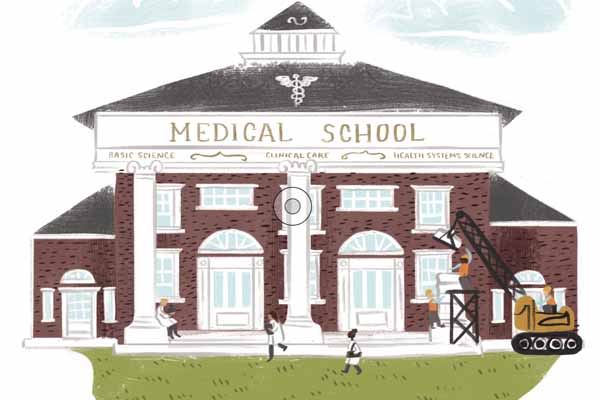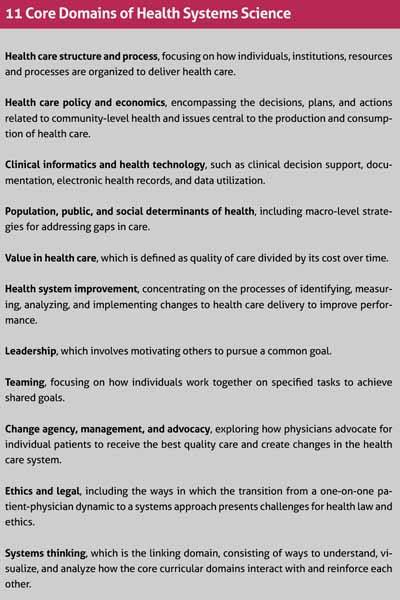
For decades, Texas medical schools – like those across the U.S. – taught students with a laser-like focus on two aspects of medicine: basic science and clinical science. But in recent years, schools have expanded medical students’ horizons to take in a bigger picture.
The schools do it by teaching “health systems science,” which is billed as medicine’s third science. Health systems science is new and evolving but the American Medical Association defines it as “understanding how care is delivered, how health care professionals work together to deliver that care, and how the health system can improve patient care and health care delivery.”
Health systems science was born in part of the realization that generations of physicians usually learned important aspects of the health system only after they had graduated from medical school, says Beth Nelson, MD, an internal medicine specialist and associate dean of undergraduate medical education at The University of Texas at Austin Dell Medical School.
For instance, most physicians had to wait until they were a resident or practicing physician to learn that patients’ level of insurance coverage or their ZIP code might affect their prospects for getting well more than anything that takes place in an exam room, she says.
“Being an effective physician is not just about understanding medicine but understanding the system in which they work and the environment in which the patients live,” Dr. Nelson said.
The ideas for health systems science have been around for decades, but they coalesced into a single framework in the early 2010s, according to a November 2020 article in Medical Science Educator
In 2016, health systems science gained greater traction after AMA promoted it through its Accelerating Change in Medical Education Consortium, which pushes for innovation in medical schools (tma.tips/AMAConsortium).
It’s unclear how extensively Texas’ 15 medical schools teach health systems science.
Nationwide, many schools teach some aspects of health systems science, but the degree of their involvement can vary greatly; some schools might just have one course on health systems science while others integrate it into almost every aspect of the curriculum, says Christine Garcia Roth, MD. The professor of pathology and immunology leads the effort at Baylor College of Medicine in Houston to incorporate health systems science into the curriculum.
Research shows that despite movement toward health systems science, “there remains uncertainty and significant inconsistency in the application of health systems science concepts and nomenclature within health care and medical education,” according to a September 2020 study published in Academic Medicine.
In Texas, newer medical schools have been the most likely to embrace health systems science because they can more easily build it into the curriculum from the ground up instead of trying to alter an existing curriculum, says Sue Cox, MD, executive vice dean for academics and the principal designer of Dell Med’s curriculum
For instance, Dell Med – founded in 2016 – started from day one with a curriculum fully geared toward health systems science, Dr. Nelson says.
“We actually incorporate the expectations [of health systems science] within clinical learning,” she said. “So, in part of their clerkship, [students] have to demonstrate an understanding of the health system. … We are trying to shift it from just, ‘This is interesting information’ to ‘This is part of how I am a good doctor.’”
But most Texas medical schools face a vastly different curriculum landscape. For instance, Baylor – founded in 1900 – has looked for innovative ways to integrate health systems science content into its existing course schedule, Dr. Roth says. To do that, it’s used a mix of required classes, electives, and voluntary pilot programs.
Baylor’s efforts include introducing students to social determinants of health in their pre-clinical orientation, building on that knowledge in a required clinical course, and giving them the option of participating in a service-learning program that encourages work in the community and a better understanding of social determinants, Dr. Roth says.
Baylor has launched other health systems science initiatives and is committed to blending more into the curriculum, starting with first-year students, she says. But the school has to move carefully to avoid disrupting other established programs.
“To fully integrate [health systems science] into our curriculum will take time,” Dr. Roth said. “But it is a focus of our curriculum-renewal efforts.”
Environmental awareness
The AMA defines 11 “domains” of health systems science in part to help medical students understand the environment in which they’ll be teaching medicine, and medical schools teach those domains in a variety of ways. (See “11 Core Domains of Health Systems Science,” page 34.)

Like Dell Med, the University of Houston College of Medicine, founded in 2020, weaves health systems science concepts throughout its course work, says Jalyce Taylor, a second-year student. In some classes it’s a central theme; in others it’s the lens through which students view larger medical issues.
For instance, one class integrates aspects of health systems science with the review of patient case studies, she says.
“We talk about [the clinical and biological aspects of] case management for sure,” Ms. Taylor said. “But [we’re also asked] how can you include family members in the decisionmaking? How can you build trust with patients? How can you understand the social determinants of health the patient is going through?”
Health systems science also shapes students’ clinical work.
For instance, Dell Med students are taught to look for problems in the medical system as they engage with it, Dr. Cox says. In fact, students in Dell Med’s first class – in their first pediatric rotation – noticed that hospital readmissions seemed high because there was room to improve discharge instructions.
“So they took it upon themselves to create a process for discharge planning and discharge instructions before a child goes home from the hospital,” she said.
That project, which involves helping caregivers better understand medication and care instructions before discharge, has now been passed on to and refined by subsequent Dell Med classes, says Megan Lewis Smith, MD, who graduated from the school in May.
Dr. Smith helped compile three years of data on the project as part of obtaining a masters in public health degree during her third year in medical school (See “Dell’s Different Direction,” May 2017 Texas Medicine, pages 28-33, www.texmed.org/DellDifferentDirection.)
Her data showed that the initiative improved caregiver comfort with administering medications and that there was a statistically significant increase in families’ ability to understand important factors, like side effects and how long a medication should be taken.
“What we learned is that, at least in the short term, this intervention is effective in improving caregiver confidence and knowledge,” she said.
Leadership and teamwork
Three of the biggest factors driving the use of health systems science in medical schools are quality, patient complexity, and cost, according to the Medical Science Educator article. Compared to other wealthy countries, the U.S. health care system does not address any of those medical factors in an efficient way, the article says.
“As the number of patients with multimorbid, complex, and medical and psychosocial factors increases, health outcomes will depend more on teams and systems of care than the individual physician, authors wrote.
Health systems science stresses physician leadership and working in teams with health care professionals from other disciplines. So, when the University of Houston launched its medical school, it also created the Humana Integrated Health Systems Science Institute, which is designed to promote team-based care among its colleges of medicine, nursing, optometry, pharmacy, and social work, says LeChauncy Woodard, MD, a general internist and the institute’s founding director.
University of Houston medical students learn how to collaborate in interdisciplinary teams, she says. This also allows them to see the medical world from different perspectives. For instance, they may learn from patient navigators the difficulties some patients face obtaining transportation for medical services. Or they may work with optometry or pharmacy students on clinical scenarios physicians might face.
This differs greatly from the go-it-alone approach to medical decisionmaking that physicians were taught in the past, Dr. Woodard says.
Also, while medical students in the past understood that factors like lack of insurance or lack of family support could affect a patient’s health, “it really wasn’t at the forefront of what we addressed during a clinical encounter,” she said. “Now we’re teaching students that not only is it important to address the social determinants of heath – which significantly influences the health and well-being of our patients – but we’re also showing them the importance of doing it with interprofessional team members. Because one person can’t do it alone.”
The “broccoli” problem
Medical schools face some potential obstacles to adopting health systems science, whether they do it all at once or in a gradual fashion.
One of the biggest is student resistance, according to an October 2019 article in Academic Medicine. Some medical students see health systems science as a distraction from basic science and clinical work, the article says.
“Although many students are fully engaged, others are dissatisfied with curricular time dedicated to competencies not perceived as high yield,” the authors wrote. “[Health systems science] learning can be viewed as ‘broccoli’ – students may realize it is good for them in the long term, but it may not be palatable in the moment.”
Faculty training poses another potential obstacle, Dr. Roth says. Health systems science is a new concept to many experienced faculty members, so they must learn how to adapt it to their area of expertise.
Because health systems science is so new, its full impact outside academia remains unclear. For instance, Dell Med’s first class graduated in 2020, and those graduates have only been practicing medicine for a year.
But their residencies took them all over the U.S., increasing the chance that they will soon have a broader impact on health care, Dr. Cox says.
“We’re hoping [those graduates] are out there with the premises and the concepts that they learned with us and are applying them in their residencies,” she said.
Tex Med. 2021;117(6):32-35
June 2021 Texas Medicine Contents
Texas Medicine Main Page